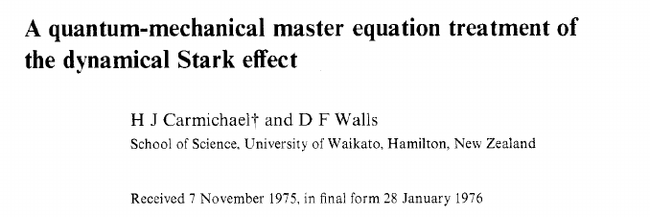A quantum-mechanical master equation treatment of the dynamical Stark effect. H. J. Carmichael and D. F. Walls in J. Phys. B.: At. Mol. Phys. 9:1199 (1976). What the paper says!?

This page is still in progress.
This provides the master equation approach to the Mollow triplet, tracing over the light field (taken to be a coherent state) to focus on the two-level system.
It shows that quantum fluctuations rule the spectrum (?!)
the second-order correlation function may be extracted with little extra work from the same equations that give atomic matrix elements and the first-order correlation function. This is a feature which has not previously been discussed in the literature and has considerable significance in that it gives rise to an interesting proposal for the measurement of spectral detail by optical homodyne or heterodyne spectroscopy.
This paper can be quoted for the first expression of $g^{(2)}(\tau)$ of coherent driving (we should have quoted it ourselves in Ref. [1] when getting Eq. (14) and also their (6.7) which is our (15)):

Title
The Mollow triplet was still called the dynamical Stark effect, making this pioneering paper a bit obscure to younger audiences.
Quotes
On the Mollow triplet becoming agreed upon by everybody:
Although in the course of this ‘dialogue’ differences have arisen in the various predictions, there appears now to be emerging a general agreement on the form of the scattered spectrum for intense fields and its long-time behaviour.
Imprecise and/or faulty
- weak scattering is well-described by the harmonic oscillator (this overlooks 2nd-order photon process which are qualitatively important).
